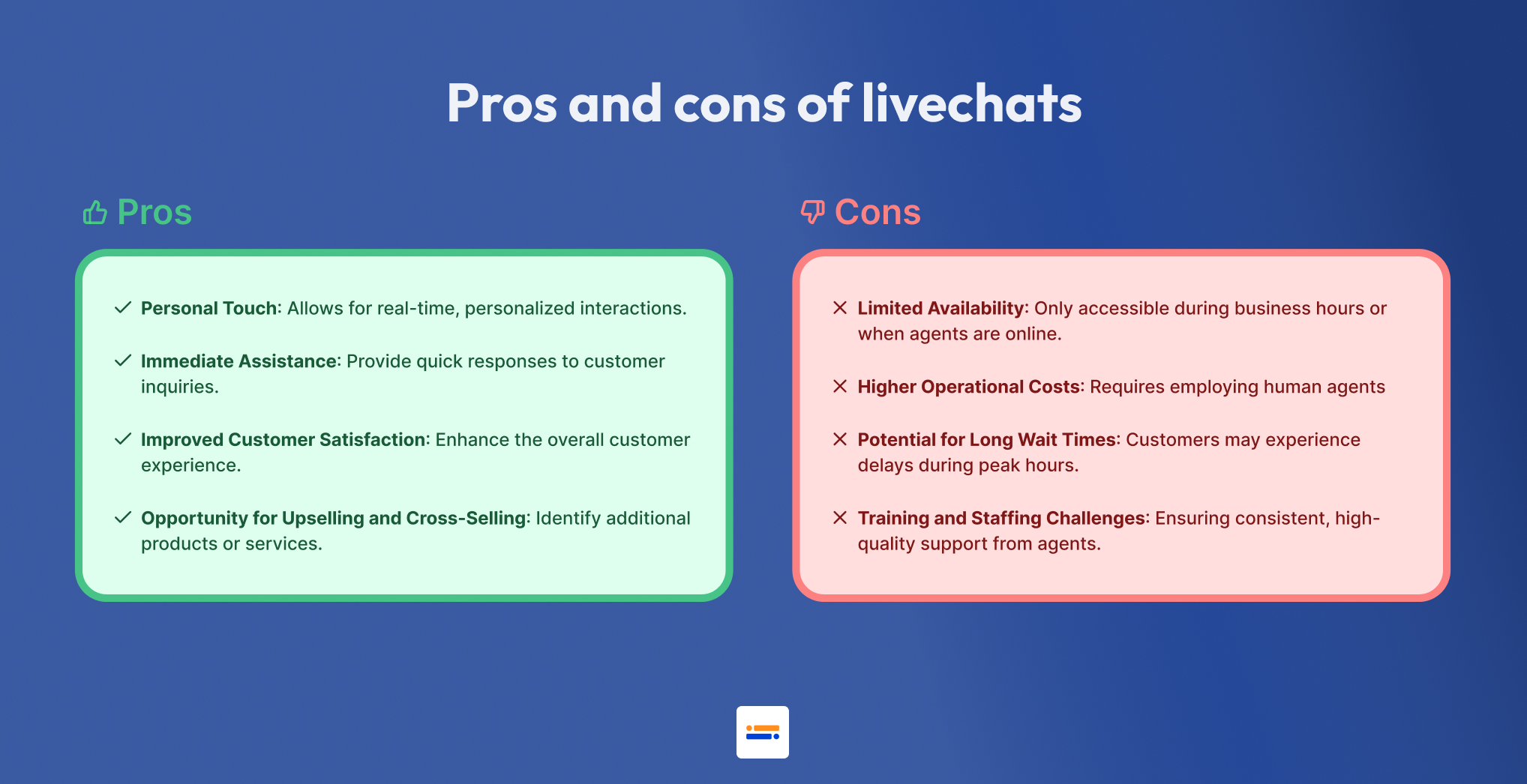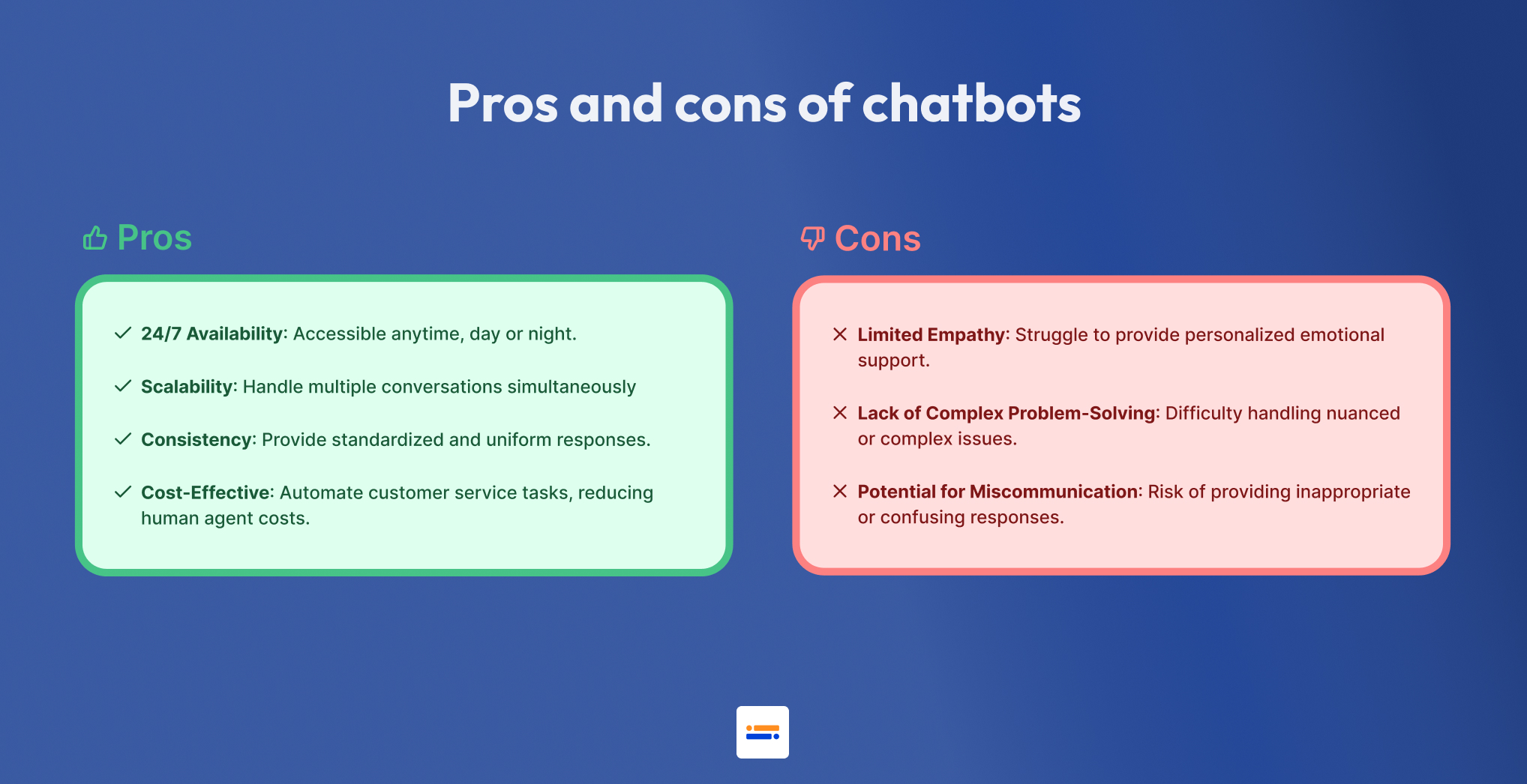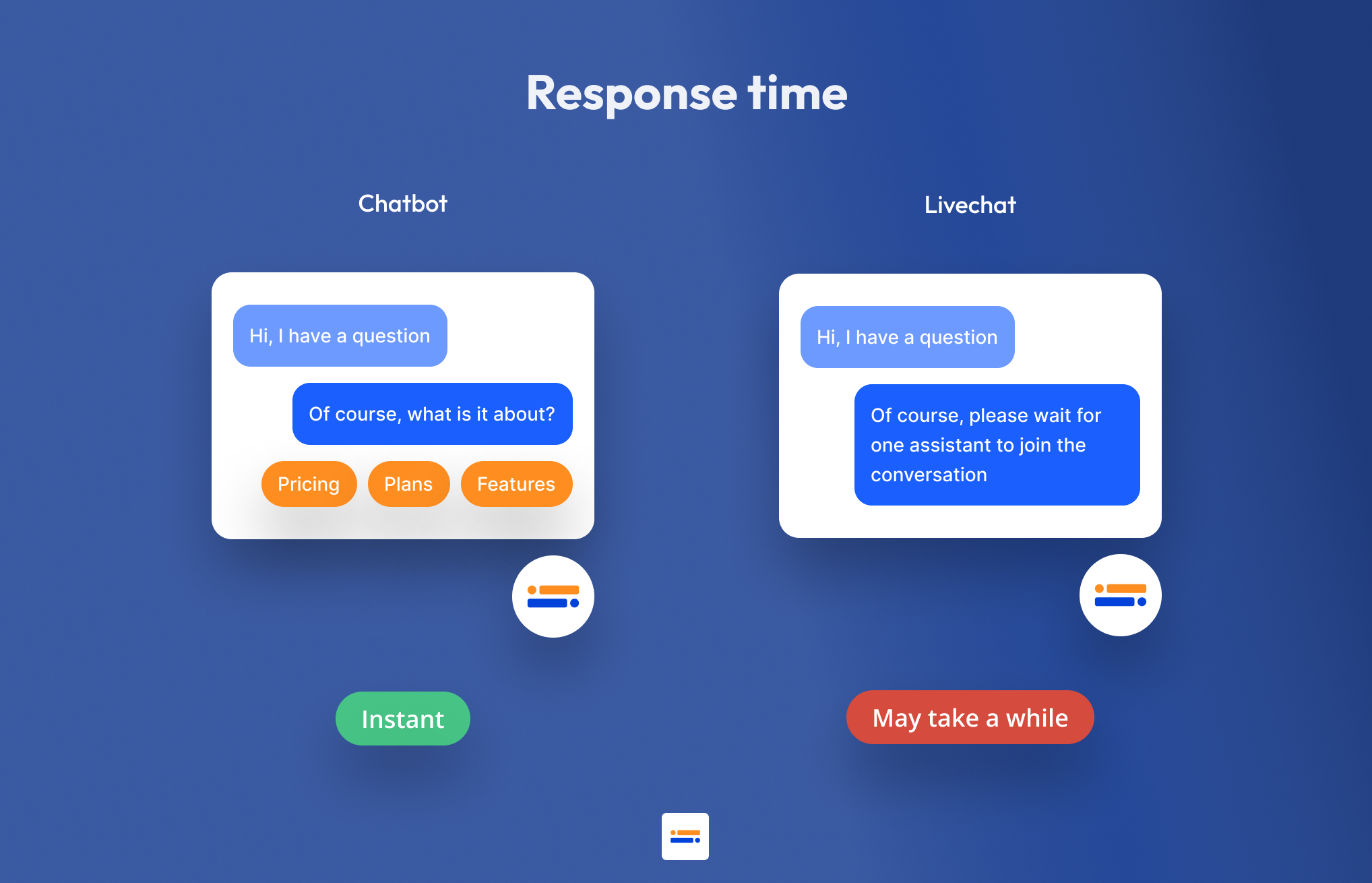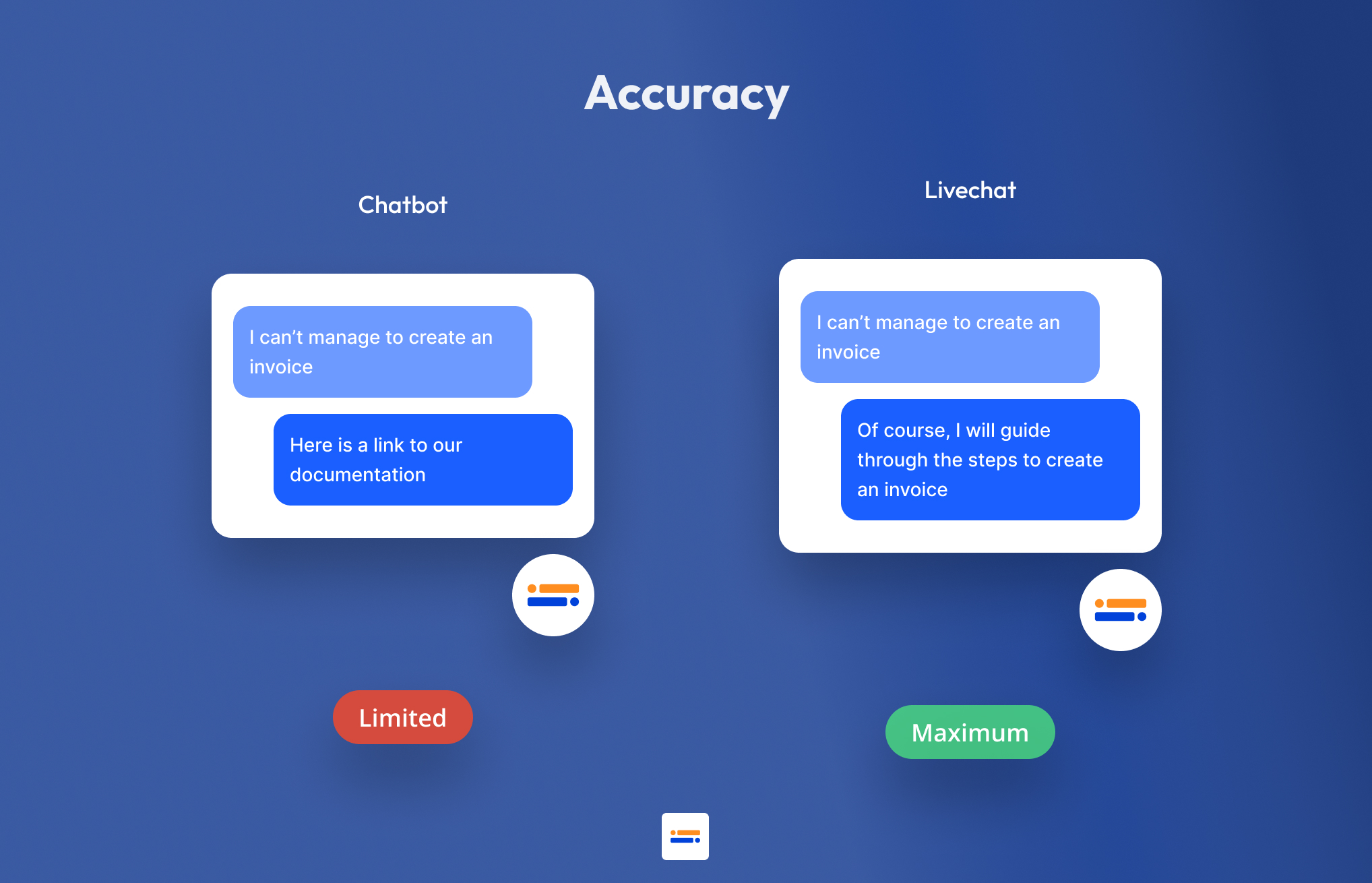Live Chat vs Chatbot: Which is Best for Your Business?
Providing instant, personalized customer support is essential for modern businesses. But with the rise of both live chat and chatbot technologies, many businesses face a tough choice: which one should they choose?
Each option offers unique advantages. Understanding their differences and how they fit your specific needs is the key. This article explores livechat vs chatbot, examining their strengths and weaknesses. Our goal is to help you make an informed decision to boost customer satisfaction and elevate your customer experience.
Here are the key differences between a chatbot and a livechat in a nutshell:
| Feature | Live Chat | Chatbot |
|---|---|---|
| Response Time | Dependent on agent availability; may vary | Instant, 24/7 responses |
| Availability | Limited by agent schedules | Available round-the-clock |
| Customer Service Costs | Higher due to hiring and training agents | Lower, as they require fewer resources |
| Scalability | Requires more agents for increased demand | Highly scalable; can handle more inquiries |
| Personalization | High; human agents can tailor responses | Limited; struggles with complex or nuanced issues |
| Accuracy | Agents can provide contextual responses | Consistent but may lack contextual understanding |
| Implementation and Ease of Use | Requires training and system integration | Easier to set up with user-friendly platforms |
| Security Considerations | Human oversight helps with sensitive info | Vulnerable to security issues if not well-secured |
What is Live Chat?

Live chat is a real-time, text-based communication channel that allows customers to interact directly with human representatives through a website or mobile app.
When a visitor initiates a chat, they connect with a live agent who can provide immediate assistance, answer questions, and resolve issues on the spot. This personal touch sets live chat apart from other support channels as it helps businesses build rapport and trust with their customers.
Common Uses for Live Chat
One of the most common uses for live chat is customer support. By offering instant access to knowledgeable agents, businesses can:
- Quickly address concerns
- Troubleshoot problems
- Provide guidance without needing phone calls or lengthy email exchanges
Live chat is also frequently used for sales and lead generation. It enables representatives to engage with potential customers, answer product-related questions, and guide them through the purchasing process.
Industry Applications
Across various industries, live chat enhances customer experiences:
- In ecommerce: Live chat assists shoppers with product selection, answers questions about sizing or shipping, and even upsells complementary items.
- In the financial sector: Live chat provides account support, helps with transactions, and offers investment guidance.
- In the travel industry: Live chat books reservations, provides destination recommendations, and assists with itinerary changes.
Overall, live chat offers a personal and immediate solution for customer interaction. It leverages live chat agents to create a seamless customer experience, making it a powerful tool for any business.
What are Chatbots?
Chatbots are computer programs that simulate human conversation through text or voice interactions. Unlike live chat, which relies on human agents, chatbots use artificial intelligence (AI) and natural language processing (NLP) to understand user inquiries and provide automated responses.
These virtual assistants handle tasks ranging from answering frequently asked questions to guiding users through complex processes.
Common Uses for Chatbots
Chatbots are commonly used for customer service. They offer instant, 24/7 support without needing human intervention. By managing routine inquiries and simple tasks, chatbots free human agents to focus on more complex issues requiring a personal touch.
Chatbots also play a role in lead generation and sales, engaging with potential customers, providing product recommendations, and facilitating transactions.
Types of Chatbots
There are two main types of chatbots:
- Rule-Based Chatbots: These follow a predefined set of rules, responding only to specific programmed inquiries. They are easy to implement but limited in understanding complex queries or providing personalized responses.
- AI-Powered Chatbots: These use machine learning algorithms or LLM to improve their understanding of user inquiries, offering more accurate and contextually relevant responses.
Chatbots serve as a cost-effective way to provide instant responses and continuous support. They allow businesses to scale efficiently, gathering customer data to refine their operations and enhance the customer experience.
For more insights, check out this comprehensive guide on chatbot best practices.
Pros and Cons of Live Chat and Chatbots
Both live chat and chatbots have their strengths and weaknesses. Businesses need to carefully weigh these when deciding which to implement.

Advantages of Live Chat
- Personal touch: Live chat allows agents to provide empathy, build rapport, and create a human connection with customers.
- Handling complex issues: Human agents can manage nuanced, sensitive, or complex inquiries requiring contextual understanding.
- Upselling opportunities: Live chat agents can identify opportunities to upsell or cross-sell products based on customer needs and preferences.
Disadvantages of Live Chat
- Limited availability: Live chat is typically available only during business hours, which can be inconvenient for customers needing assistance outside those times.
- Higher costs: Implementing and maintaining a live chat system is costly, requiring businesses to hire, train, and manage human agents.
- Longer wait times: During peak hours or with limited staff, customers may have to wait for an available agent, leading to longer response times.

Advantages of Chatbots
- 24/7 availability: Chatbots provide instant, round-the-clock support, ensuring customers always have access to assistance.
- Cost-effective: While requiring an initial investment, chatbots help reduce customer service costs long-term by handling high volumes of inquiries without additional staff.
- Scalability: Chatbots can easily scale to manage a growing volume of inquiries without additional resources.
Disadvantages of Chatbots
- Lack of personal touch: AI-powered chatbots may struggle to fully replicate the empathy and human connection of live chat.
- Limited understanding: Chatbots may provide irrelevant or incorrect responses, especially with ambiguous or multi-faceted issues.
- Implementation complexity: Setting up an AI-powered chatbot can be complex, requiring careful planning, design, and training to ensure accurate, helpful responses.
User Preferences and Trends
Consider user preferences and trends when choosing between live chat and chatbots. Many customers still prefer human interaction for complex or sensitive issues, valuing the human touch. Others appreciate the speed and convenience of chatbots for simple inquiries.
As AI technology advances, chatbots become increasingly sophisticated, and their adoption grows across industries. However, balancing automation with the human touch is essential to provide the best possible customer experience.
By understanding the advantages and disadvantages of live chat vs chatbot solutions, you can make an informed decision that aligns with your business needs and customer expectations.
Key Differences Between Live Chat and Chatbots
While both live chat and chatbots aim to provide instant, convenient customer support, several key differences can impact your decision on which to implement.
Response Time

With live chat, customers might wait for an available agent, especially during peak hours or if staffing is limited. Chatbots provide instant responses 24/7, regardless of the inquiry volume.
Availability
Live chat is typically available only during business hours. This limitation can be frustrating for customers needing assistance outside those times. Chatbots, however, operate around the clock, providing support whenever customers need it.
Customer Service Costs
Maintaining a live chat system can be costly due to the need to hire, train, and manage human agents. Chatbots require an initial investment but help reduce long-term customer service costs by handling a high volume of inquiries without extra staff.
Scalability
As businesses grow, scaling a live chat system involves hiring and training more agents, which can be challenging. Chatbots easily scale to manage an increasing volume of inquiries without needing additional resources.
Personalization
Live chat offers a personalized experience. Human agents can show empathy, build rapport, and tailor responses to each customer's unique needs. AI-powered chatbots can provide relevant responses but may struggle to fully replicate the human touch.
Accuracy

Human agents use their experience and intuition to offer accurate, nuanced responses to complex issues. Chatbots, while improving, may sometimes provide irrelevant or incorrect answers, especially with ambiguous or multi-faceted inquiries.
Implementation and Ease of Use
Implementing a live chat system involves integrating a chat widget into your website and training agents. Chatbots, especially AI-powered ones, require careful planning, design, and training to ensure they provide accurate and helpful responses.
Integration Capabilities
Consider the integration capabilities of live chat and chatbots with platforms like WhatsApp and Facebook Messenger.
Chatbots, utilizing API technologies, can provide consistent support across multiple channels and handle common queries, automate responses, and ensure 24/7 availability. Both live chat and chatbots offer significant integration possibilities.
Security Considerations
When handling sensitive information, securing your support channels is crucial. Live chat requires robust security measures to protect customer data and prevent unauthorized access. Chatbots, being automated, can be programmed to follow strict security protocols and handle sensitive data with care.
Choosing between live chat and chatbots depends on your business needs, customer engagement goals, and how you plan to balance personalized responses with instant, cost-effective support.

No trial. Generous free plan.
Combining Live Chat and Chatbots for Optimal Results
Live chat and chatbots each have unique strengths, but you don't have to choose between them. Combining both can offer an efficient customer experience that balances speed, convenience, and personal touch.
Benefits of a Hybrid Approach
By integrating both live chat and chatbots, businesses can:
- Provide 24/7 support: Chatbots handle inquiries outside business hours, while live chat agents take over during peak times or for complex issues.
- Reduce response times: Chatbots offer instant answers to simple questions, freeing live chat agents to focus on complex inquiries requiring human touch.
- Improve efficiency: Chatbots manage routine inquiries, allowing live chat agents to focus on high-value interactions needing empathy and contextual understanding.
- Enhance personalization: Chatbots gather data on customer preferences and behavior, which live chat agents use to provide more targeted support.
- Increase customer satisfaction: Combining chatbots' speed and convenience with live agents' empathy and problem-solving skills creates a well-rounded customer experience.
Best Practices for Integration
To successfully integrate live chat and chatbots, follow these best practices:
- Define clear roles and handoffs: Establish guidelines for when chatbots should transfer inquiries to live chat agents, ensuring a seamless transition.
- Train chatbots and agents: Regularly update chatbots and train them to handle a broader range of inquiries. Ensure live chat agents understand the chatbot's capabilities and limitations.
- Monitor performance and gather feedback: Continuously monitor both chatbots and live chat agents, and collect customer feedback to identify areas for improvement.
- Personalize interactions: Use data gathered by chatbots to inform live chat interactions, allowing agents to provide more personalized support.
- Integrate with other systems: Ensure your live chat and chatbot systems integrate with your CRM, help desk, and other customer support tools for a unified experience.
By combining the strengths of live chat and chatbots, businesses can create a powerful, flexible customer support system. This hybrid approach adapts to individual customer needs, leading to higher customer satisfaction, loyalty, and advocacy.
Conclusion
Providing exceptional customer support is more important than ever. By understanding the key differences between live chat and chatbots, businesses can make informed decisions about which approach suits their needs best. Live chat offers a personal touch and handles complex issues, while chatbots provide 24/7 availability, cost-effectiveness, and scalability.
The best solution may be a hybrid approach combining the strengths of both. This allows businesses to deliver the right level of support at the right time. Understanding your customers' needs and preferences, and continuously adapting your strategy, is key to providing the best possible customer experience.

No trial. Generous free plan.
Frequently Asked Questions
Can I use live chat and chatbots together?
Yes, combining live chat and chatbots can offer the best of both worlds. By integrating the two, businesses provide 24/7 support, reduce response times, improve efficiency, enhance personalization, and boost customer satisfaction. Chatbots handle simple, routine inquiries, while live chat agents focus on complex issues needing a human touch.
How do I choose between live chat and chatbots?
Choosing between live chat and chatbots depends on your business needs and goals. Consider factors such as the complexity of your customer inquiries, your target audience's preferences, your budget, and your desired level of personalization. If you frequently deal with sensitive or nuanced issues, live chat may be the better choice. If you want to provide 24/7 support and handle a high volume of simple inquiries, chatbots may be more suitable.
What are the costs associated with implementing live chat or chatbots?
The costs of implementing live chat or chatbots vary based on the size of your business, complexity, and provider. Live chat requires a larger initial investment in hiring and training agents. Chatbots may have higher upfront development costs but can offer long-term savings by managing a high volume of inquiries without additional staff.
How do chatbots handle complex queries?
Chatbots are becoming more sophisticated thanks to advances in AI and natural language processing. However, they may still struggle with complex, multi-faceted queries requiring contextual understanding and empathy. In these cases, it's important to have a seamless handoff to live chat agents who can provide more personalized support.
Can Typebot integrate with my existing tools and platforms?
Yes, Typebot offers a range of integrations with popular tools and platforms, including Zapier, Google Sheets, and Slack. This allows you to seamlessly connect your chatbot with your existing workflow, making it easy to manage customer interactions, store data, and trigger actions across your tech stack.